Helicopter-light-beams – a new tool for quantum optics
Advertisement
Storing light in a bottle is easier than one might think: Laser light can be coupled into an optical glass fiber in such a way that it does not travel along the fiber but rather spirals around it in a bulged, bottle-like section. In such a bottle microresonator light can be stored for about ten nanoseconds, corresponding to 30,000 revolutions around the fiber. This is long enough to enable interactions between the light and single atoms, which are brought very close to the fiber surface.

A transversal wave transfers light into a glass fiber, where it is stored in a bottle microresonator. Atoms close to the fiber couple to the light wave.
TU Wien
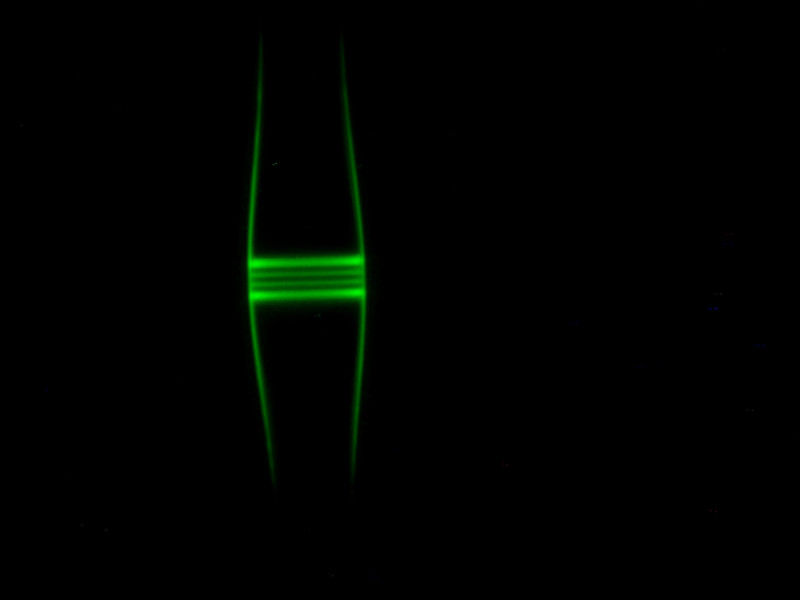
In a glass fiber - with about half the diameter of a human hair - light is kept in place. It cannot escape, because the diameter of the fiber decreases on both sides.
TU Wien
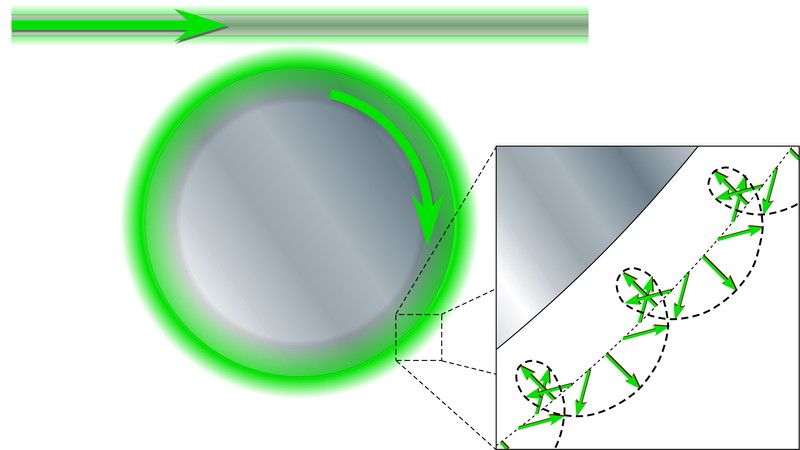
The polarization of the light wave has a longitudinal component - therefore, the polarization direction resembles the tips of the rotor of a flying helicopter, describing a cycloid.
TU Wien
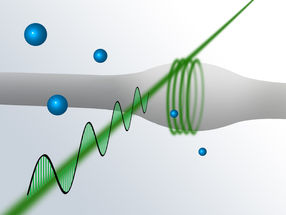
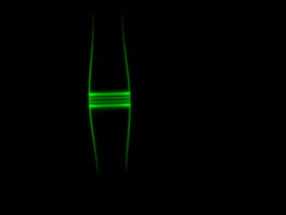
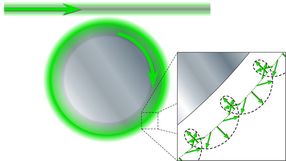
Now, scientists at the TU Vienna discovered that in this situation light and matter couple much stronger than previously expected. This surprising result stems from an exceptional property of light inside such microresonators: It oscillates in the longitudinal direction.
Propeller plane or helicopter?
Light waves can oscillate in a fixed direction or twist like a corkscrew. However, for plane light waves, this oscillation - one also speaks of polarization - is always transversal, i.e., perpendicular to its propagation direction. “One can picture this like the propeller of an aircraft: its rotation is always perpendicular to the direction of motion,” explains Prof. Arno Rauschenbeutel (Vienna Center for Quantum Science and Technology, Institute of Atomic and Subatomic Physics, TU Vienna). “However, the light confined in our bottle microresonator also has a longitudinal component, oscillating along the propagation direction. Thus, the light wave rather resembles the rotor of a horizontally flying helicopter. While the tips of the aircraft propeller trace out a corkscrew-like path through space, the trajectories of the tips of the helicopter rotor describe a more complicated trajectory – a so-called cycloid.”
Superposition of waves
The direction of the oscillation is of major importance for the behavior of the light wave. In the bottle microresonator, light can travel clockwise and counterclockwise around the fiber. If the polarization of the two counter-propagating light waves is transverse, they will enhance each other at certain locations while cancelling out in other places. “It is this destructive interference which limits the coupling strength between the light waves and the atoms around the glass fiber,” states Arno Rauschenbeutel.
However, if the two light waves also oscillate along the direction of propagation, their oscillation states will inevitably differ. As a consequence, a complete cancellation of counter-propagating beams by destructive interference is not possible anymore. “Initially, we were really surprised: it was already known before that light can oscillate longitudinally but, up to now, no one considered its importance in the context of light-matter interactions in microresonators,” explains Arno Rauschenbeutel.
Coupling of light and matter
The results from the quantum-optics labs at the TU Vienna could give a new twist to research concerned with longitudinally oscillating light waves in very different scientific fields: Even a focused laser beam in free space has a longitudinal component. “Most importantly for our research, we now understand that our experimental method works much better than expected,” says Arno Rauschenbeutel. “We realize a very strong coupling between light in the glass fiber and single atoms that are situated very close to the fiber.”
This opens up the possibility of constructing extremely sensitive sensors with the ability to detect single atoms with light. Furthermore, bottle microresonators turn out to be ideal tools for studying the fundamental properties of light-matter interactions. The scientists’ next plan is to realize a router for light that is controlled by a single atom and switches light between two output ports. In the future, such a quantum-mechanical router could then be used for interconnecting future quantum computers in optical fiber networks.
Original publication
Other news from the department science
These products might interest you
Most read news
More news from our other portals
See the theme worlds for related content
Topic world Sensor technology
Sensor technology has revolutionized the chemical industry by providing accurate, timely and reliable data across a wide range of processes. From monitoring critical parameters in production lines to early detection of potential malfunctions or hazards, sensors are the silent sentinels that ensure quality, efficiency and safety.

Topic world Sensor technology
Sensor technology has revolutionized the chemical industry by providing accurate, timely and reliable data across a wide range of processes. From monitoring critical parameters in production lines to early detection of potential malfunctions or hazards, sensors are the silent sentinels that ensure quality, efficiency and safety.



































































